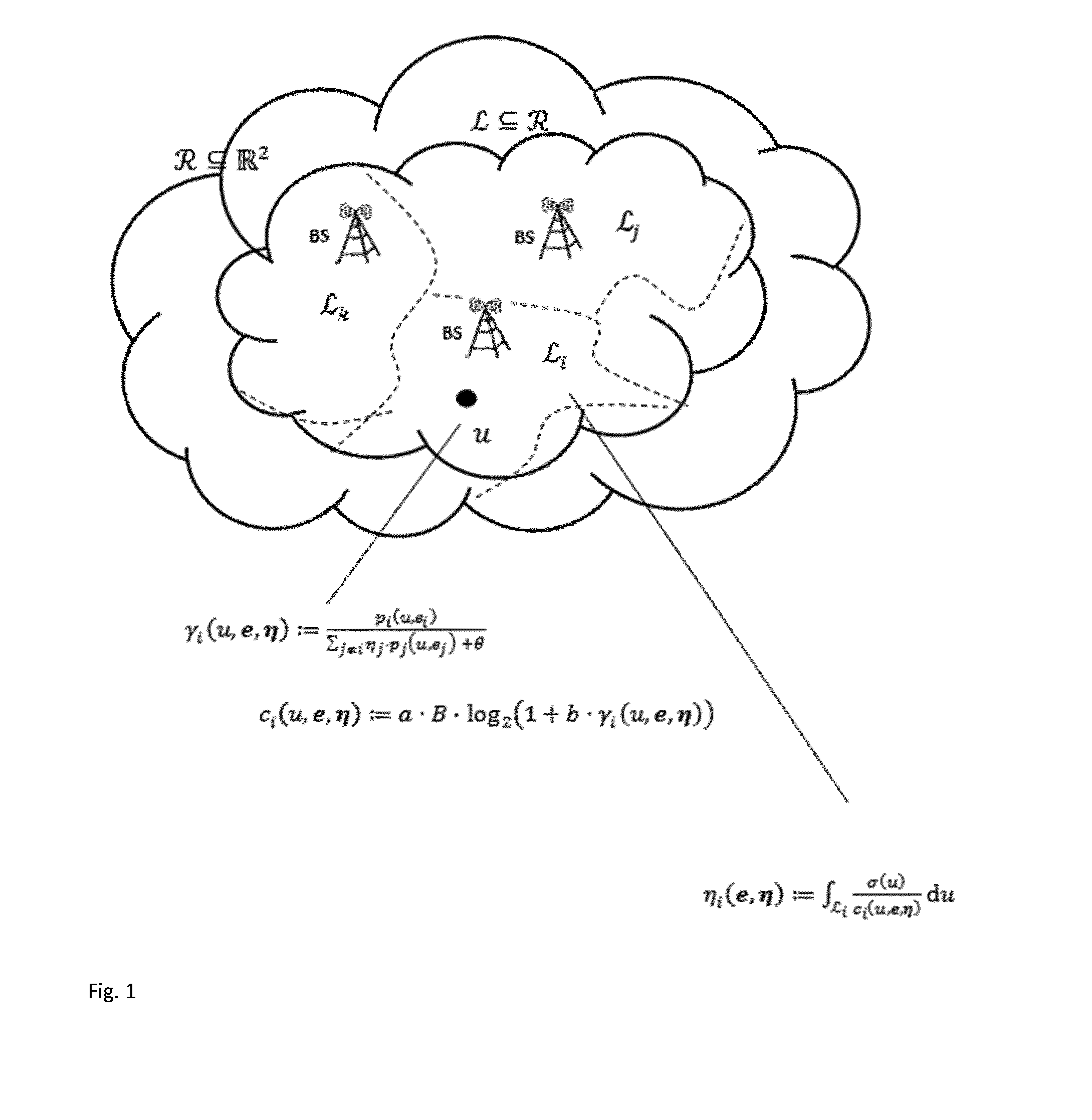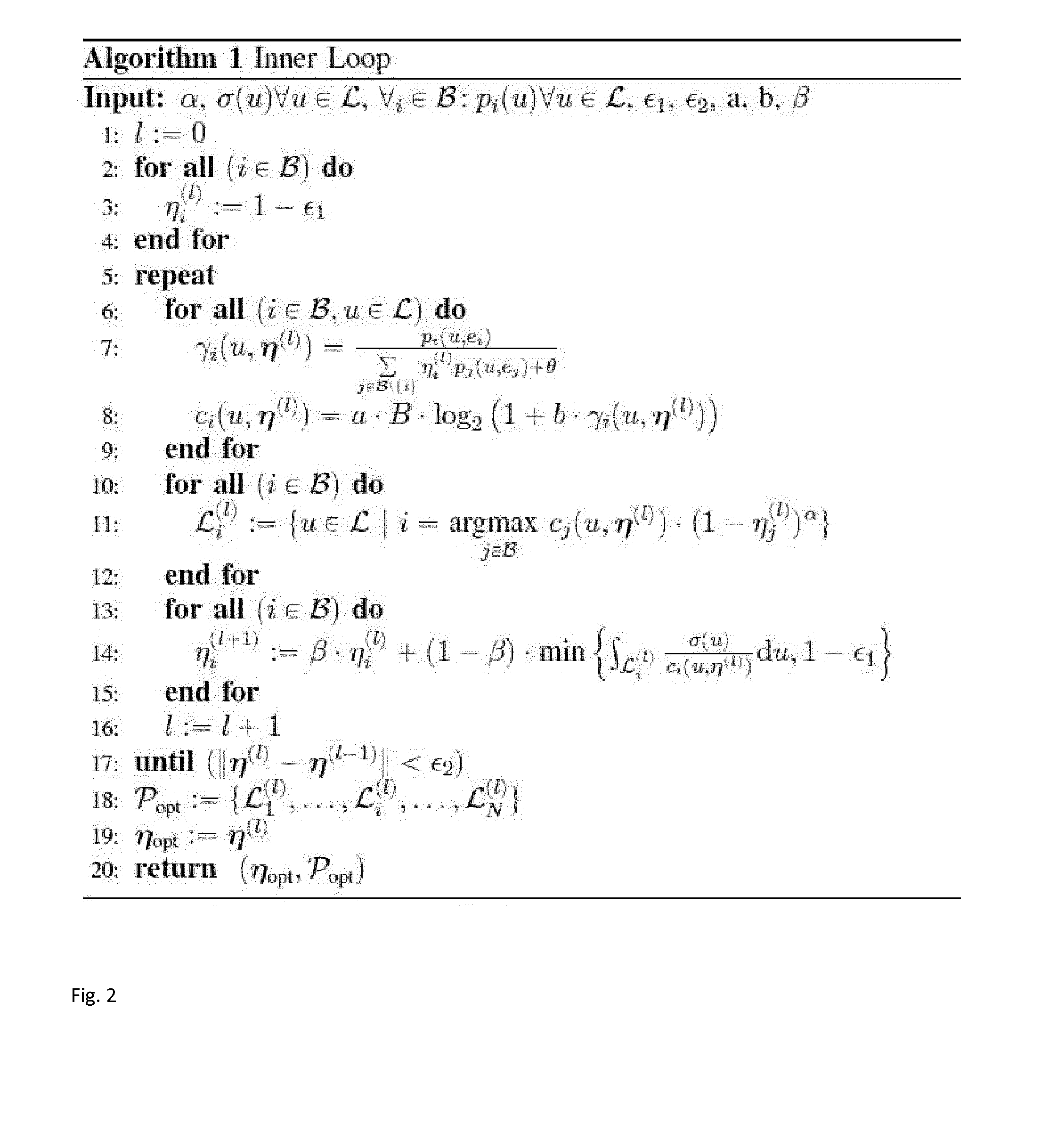Method for joint and coordinated load balancing and coverage and capacity optimization in cellular communication networks
a technology of cellular communication network and load balancing, applied in the field of network planning, to achieve the effect of preventing over- and under-load of bss and minimizing the maximum bs load
- Summary
- Abstract
- Description
- Claims
- Application Information
AI Technical Summary
Benefits of technology
Problems solved by technology
Method used
Image
Examples
embodiment one
[0145]This embodiment describes a variant of the inventive method which calculates the optimal partition of the served area for fixed physical base station parameters e and fixed load balancing parameter α.
[0146]The optimal partition opt is calculated using the “inner loop” algorithm and directly transformed to CIO values afterwards as described above. Then the CIO values are applied to the cellular network configuration management.
embodiment two
[0147]This embodiment describes a variant of the inventive method which calculates the optimal partition of the served area for a fixed load balancing parameter α while optimizing using direct search over the antenna tilts e∈{0, . . . ,15}N) as subset of the physical parameters of the base stations. This embodiment shows different examples of the policies needed in the outer loop. The algorithm is shown in FIG. 4.
[0148]The tilt ei is chosen from the set εi={ei−eΔ°, . . . , ei+eΔ°}according to the rule as follows:[0149](1) If none of the elements in εi fulfills the RSRP coverage constraint, the element is chosen that maximizes the RSRP coverage rx. Otherwise, go to (2).[0150](2) If none of the elements in εi fulfills the RSRP and SINR coverage constraints, the element is chosen that fulfills the RSRP coverage constraint and maximizes SINR coverage γ. Otherwise, go to (3).[0151](3) If none of the elements in εi fulfills the RSRP and SINR coverage and supremum load constrains, the elem...
embodiment three
[0154]This embodiment describes a variant of the inventive method which calculates the optimal partition of the served area for fixed physical base station parameters e while optimizing over the load balancing parameter α≧0.
[0155]Network statistics show a specific behavior as the load balancing parameter α varies. The following two are exploited:[0156]1. For fixed e, the maximum cell load
maxi{ηi(e,α)}
in the cluster to be optimized shows monotonically decreasing behavior as α increases. The minimum value for which the supremum load constraint is fulfilled, i. e., ηi(e, α)≦ηsup, ∀i ∈, is denoted as αmin.[0157]2. For fixed e, the SINR coverage γ(e, α) in the cluster to be optimized shows monotonically decreasing behavior as α increases. The maximum value for which the SINR coverage constraint is fulfilled, i. e., γ(e, α)≧γ,min, is denoted as αmax.
[0158]Formally, the rule for selecting α is as follows:
α=fα(αmax,αmin):={0if(γ(αmin)<γ,minorγ(αmax)<γ,min)αmaxifαmin>αmax,αminotherw...
PUM
 Login to View More
Login to View More Abstract
Description
Claims
Application Information
 Login to View More
Login to View More - R&D
- Intellectual Property
- Life Sciences
- Materials
- Tech Scout
- Unparalleled Data Quality
- Higher Quality Content
- 60% Fewer Hallucinations
Browse by: Latest US Patents, China's latest patents, Technical Efficacy Thesaurus, Application Domain, Technology Topic, Popular Technical Reports.
© 2025 PatSnap. All rights reserved.Legal|Privacy policy|Modern Slavery Act Transparency Statement|Sitemap|About US| Contact US: help@patsnap.com



